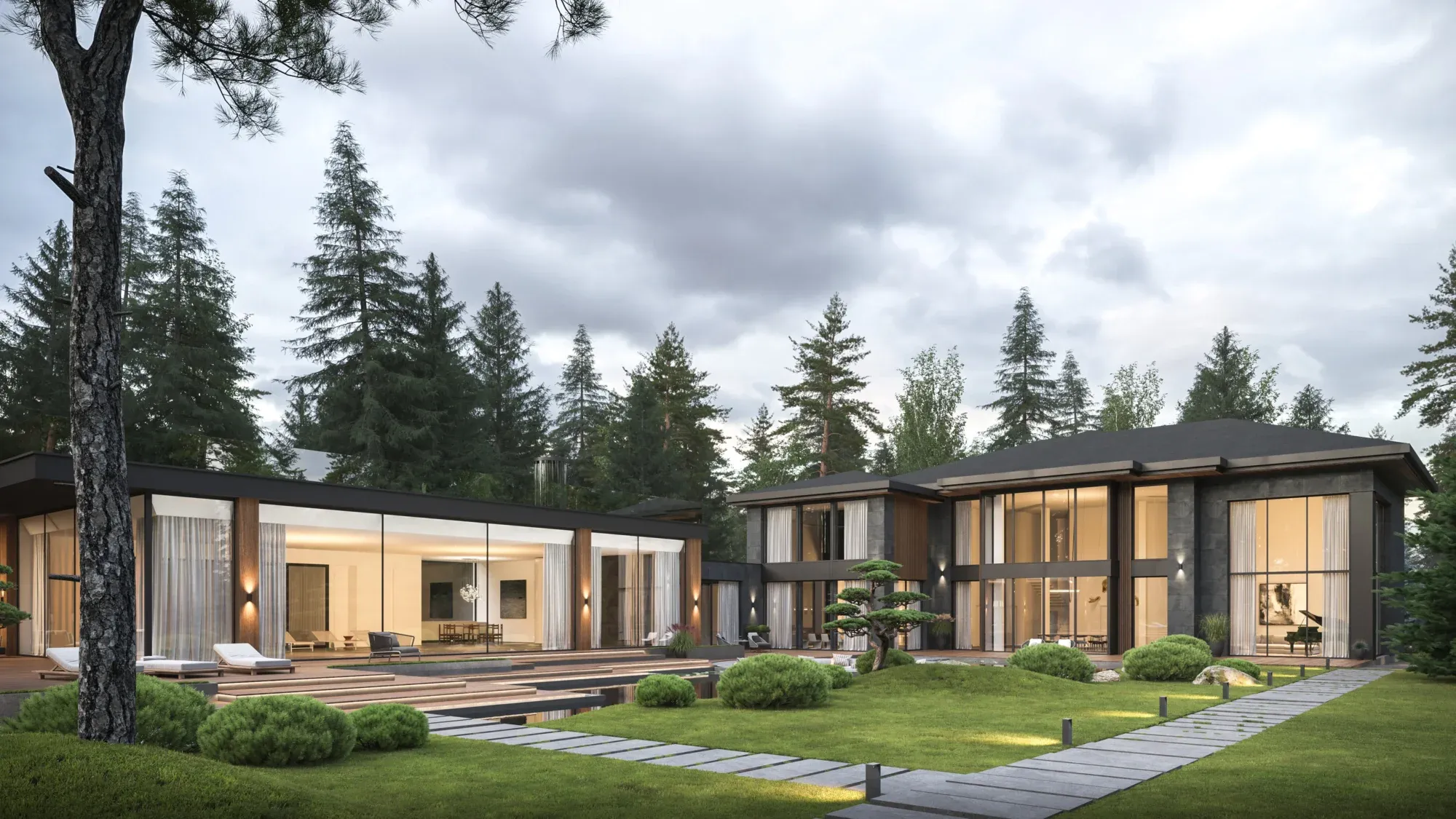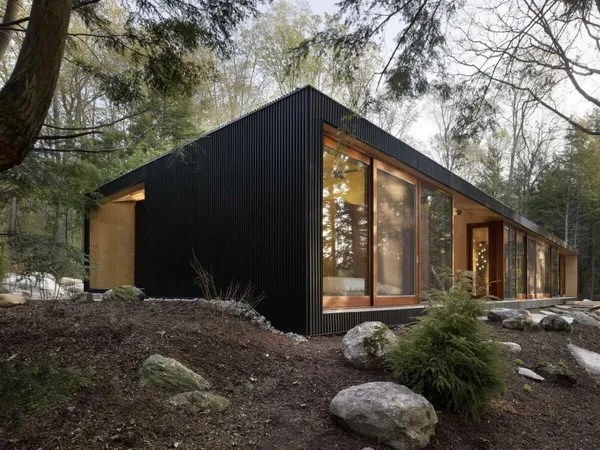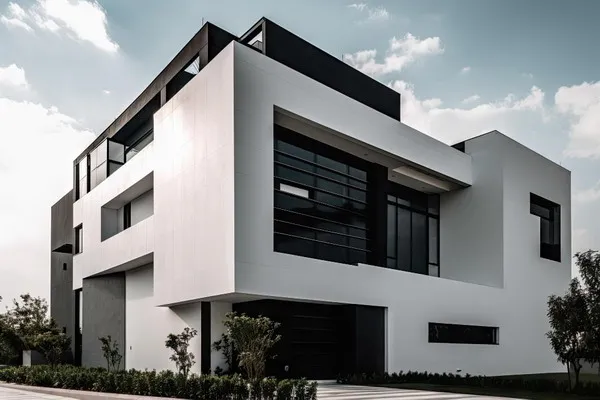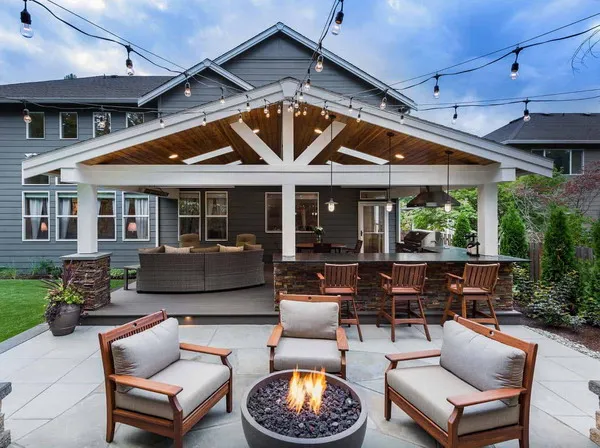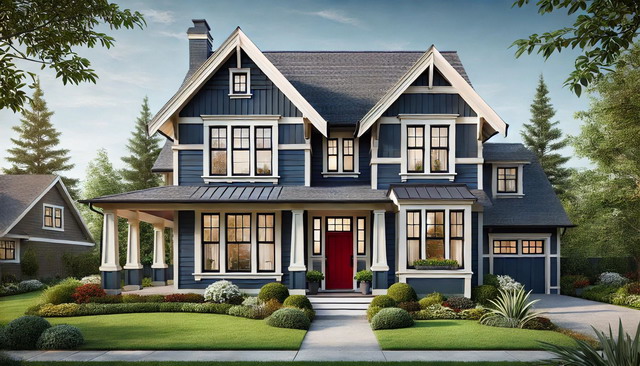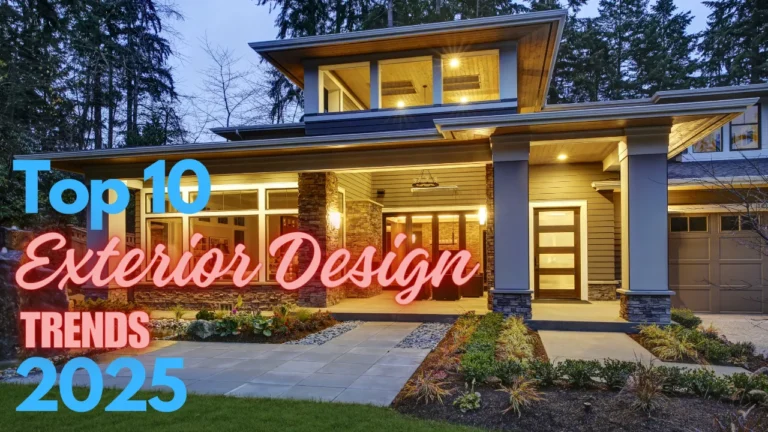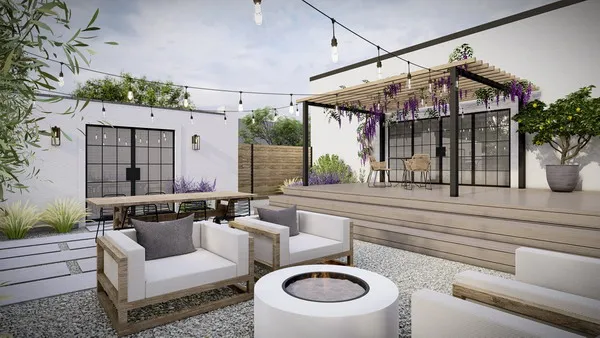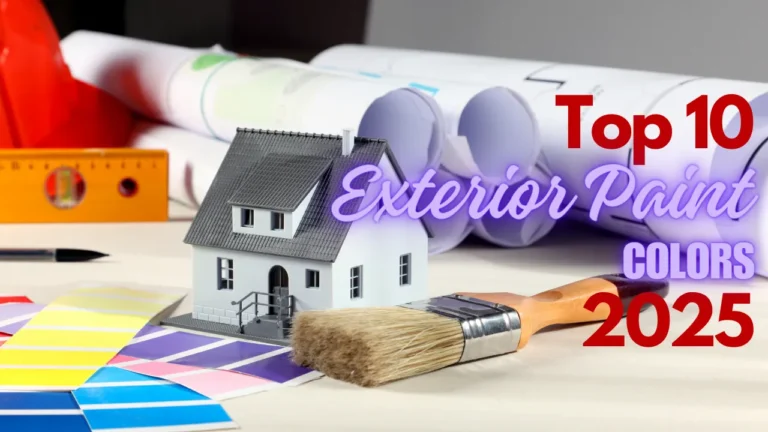Top Home Trends 2025: Modern Design & Sustainable Living
Last Updated on September 14, 2024 by Mutiara
As we look ahead to 2025, it’s clear that the way we design and live in our homes is undergoing a remarkable transformation. Driven by advances in technology, growing environmental awareness, and shifting lifestyle preferences, the home trends of 2025 reflect a deeper connection between the spaces we inhabit and the lives we lead. Homeowners are no longer simply seeking comfort and style—they want homes that enhance their well-being, adapt to their needs, and contribute to a more sustainable future.
From eco-friendly materials and smart home technologies to biophilic design and flexible living spaces, these trends represent a bold new era of innovation in home design. Sustainability is at the forefront, with an increasing focus on reducing environmental impact without sacrificing luxury or modern conveniences. Technology, too, is playing a pivotal role, transforming homes into interconnected ecosystems that cater to our daily routines, health, and entertainment.
In this article, we’ll dive into the key home trends shaping 2025, exploring everything from the rise of outdoor living spaces to the integration of wellness-centered designs. Whether you’re planning a major renovation, building a new home, or simply looking to refresh your living space, these insights will help you stay ahead of the curve and create a home that’s not only beautiful but also forward-thinking. Welcome to the future of home design.
1. Sustainable and Eco-Friendly Home Materials 2025
As we approach 2025, the home design industry is experiencing a significant shift towards sustainability and eco-friendliness. Homeowners are becoming increasingly conscious of their environmental footprint, driving a demand for materials that are not only aesthetically pleasing but also kind to the planet. This rise in eco-consciousness is reshaping the way we think about building and decorating our homes, making sustainable home materials 2025 a hot topic among designers and consumers alike.
One of the most prominent materials leading this green revolution is recycled wood. Reclaimed from old buildings, barns, and even wine barrels, recycled wood offers a rustic charm that new lumber simply can’t replicate. Its unique character adds warmth and history to any space, whether used for flooring, furniture, or accent walls. By choosing recycled wood, homeowners are not only reducing the demand for new timber but also keeping valuable resources out of landfills.
Bamboo is another sustainable superstar making waves in home design. Often mistaken for wood, bamboo is actually a fast-growing grass that regenerates quickly after harvesting, making it an incredibly renewable resource. Its strength and durability make it suitable for a variety of applications, from flooring and cabinetry to decorative elements. Plus, bamboo’s sleek, modern look fits seamlessly into both contemporary and traditional design schemes.
Organic textiles are also gaining popularity as homeowners seek out healthier, more sustainable options for their living spaces. Materials like organic cotton, hemp, and linen are grown without harmful pesticides and chemicals, resulting in fabrics that are better for both people and the environment. These textiles are being used in everything from upholstery and drapery to bedding and rugs, adding natural beauty and comfort to homes.
In addition to these materials, innovations in eco-friendly insulation, such as sheep’s wool and recycled denim, are providing effective alternatives to traditional fiberglass insulation. These options offer excellent thermal performance while reducing energy consumption and greenhouse gas emissions.
The push towards sustainability is not just about the materials themselves but also about the processes used to produce them. Manufacturers are adopting low-impact production methods, utilizing renewable energy sources, and implementing waste reduction strategies. Certifications like LEED (Leadership in Energy and Environmental Design) and FSC (Forest Stewardship Council) are helping consumers identify products that meet stringent environmental standards.
Homeowners are also embracing the concept of circular design, which focuses on minimizing waste and maximizing the lifespan of materials. This approach encourages the use of products that can be easily repaired, reused, or recycled at the end of their life cycle.
The trend towards sustainable and eco-friendly home materials is more than just a passing fad—it’s a movement that’s reshaping the future of home design. As we look ahead to 2025, it’s clear that the integration of environmentally responsible materials will continue to grow, driven by a collective desire to create homes that are not only beautiful but also sustainable for generations to come.
2. Smart Home Technology Integration 2025
The concept of the smart home is evolving rapidly, and by 2025, it’s set to become an integral part of our daily lives. Advances in technology are transforming our living spaces into interconnected ecosystems that enhance convenience, efficiency, and security. The integration of smart devices is reshaping home functionality, making the best smart home technology 2025 a focal point for homeowners and tech enthusiasts alike.
At the heart of this transformation is automation. Smart home systems are becoming more intuitive, learning our habits and preferences to automate routine tasks. Imagine lights that adjust based on the time of day or weather conditions, thermostats that optimize energy use by learning your schedule, and blinds that open and close to maximize natural light—all without manual input.
Voice control is another significant aspect of smart home integration. Virtual assistants like Amazon’s Alexa, Google Assistant, and Apple’s Siri are becoming more sophisticated, allowing for seamless interaction with a wide range of devices. By 2025, voice-activated commands will likely extend beyond simple tasks to more complex functions, such as managing home security systems, controlling appliances, and even monitoring health indicators.
Energy efficiency is a major driver of smart home technology. Energy-efficient gadgets and systems are designed to reduce consumption and lower utility bills. Smart meters provide real-time data on energy usage, helping homeowners identify ways to conserve power. Smart appliances, like refrigerators that monitor food freshness or washing machines that optimize water use, contribute to a more sustainable household.
Security is also being enhanced through smart technology. Advanced surveillance systems with facial recognition, smart locks that provide keyless entry, and doorbell cameras that allow you to see and communicate with visitors remotely are becoming standard features. These technologies offer peace of mind by keeping homeowners connected to their properties, even when they’re away.
The integration of the Internet of Things (IoT) is expanding the capabilities of smart homes. Devices are increasingly able to communicate with each other, creating a cohesive network that can be managed through centralized platforms or apps. This interconnectedness allows for greater customization and control, tailoring the home environment to individual needs and preferences.
Health and wellness technologies are also finding their way into homes. Air purifiers that monitor air quality, smart beds that track sleep patterns, and lighting systems that adjust to support circadian rhythms are examples of how technology is promoting healthier living spaces.
Looking ahead, artificial intelligence (AI) will play a more significant role in smart homes. AI-powered systems will be able to predict needs, offer suggestions, and make autonomous decisions to enhance comfort and efficiency. For instance, a smart kitchen might suggest recipes based on the ingredients available and dietary preferences, or a home office setup might optimize lighting and temperature for productivity.
The adoption of 5G networks is expected to boost the performance of smart home devices, providing faster and more reliable connections. This advancement will enable more devices to operate simultaneously without lag, enhancing the overall user experience.
As we move towards 2025, the best smart home technology will be defined by its ability to integrate seamlessly into our lives, offering solutions that are intuitive, efficient, and personalized. The smart homes of the future will not only respond to our commands but anticipate our needs, creating living spaces that are truly in sync with the people who inhabit them.
3. Biophilic Design in 2025 Homes
As we step into 2025, the integration of nature into our living spaces—known as biophilic design—is becoming more than just a trend; it’s a lifestyle choice that promotes well-being and harmony with the environment. The concept of biophilic home design trends 2025 revolves around creating spaces that bring the outdoors inside, enhancing our connection with nature even in urban settings.
One of the most prominent features of biophilic design is the inclusion of indoor plants. Homeowners are transforming their interiors into green sanctuaries filled with a variety of plants that purify the air and add a sense of tranquility. From small succulents adorning shelves to expansive living walls that serve as stunning focal points, greenery is being used creatively to breathe life into homes.
Natural light is another crucial element. Designers are prioritizing large windows, skylights, and open layouts to maximize sunlight exposure. This not only reduces the reliance on artificial lighting but also has positive effects on mood and health. The strategic placement of mirrors and glass surfaces further amplifies natural light, making spaces feel more open and airy.
Incorporating water features such as indoor fountains, aquariums, or even small indoor ponds adds a soothing auditory and visual element to the home. The gentle sound of flowing water can reduce stress and create a calming ambiance, enhancing the overall sensory experience of the space.
Materials play a significant role in biophilic design. The use of natural materials like wood, stone, and bamboo introduces organic textures and warmth. Reclaimed wood flooring, stone accent walls, and bamboo furniture not only look appealing but also support sustainability efforts.
Textures and patterns inspired by nature are also prevalent. Organic shapes and forms in furniture and decor mimic the fluidity of the natural world. Leaf motifs, floral patterns, and earthy color palettes contribute to a cohesive design that feels both modern and connected to the environment.
The integration of indoor and outdoor spaces is a hallmark of biophilic design in 2025. Sliding glass doors, indoor gardens, and transitional spaces like sunrooms blur the lines between the interior and exterior. This seamless connection encourages a lifestyle that appreciates and enjoys nature daily.
Moreover, technology is being used to enhance biophilic elements. Smart irrigation systems for indoor plants, automated blinds that adjust to natural light levels, and air purification systems that mimic natural airflow are just a few examples of how innovation supports this design approach.
By embracing biophilic design, homeowners are not only creating aesthetically pleasing environments but also promoting a healthier, more balanced lifestyle. The emphasis on natural elements fosters a sense of peace and well-being, making homes true sanctuaries in the bustling modern world.
4. Minimalist and Functional Living Spaces
In 2025, the mantra “less is more” has never been more relevant, as homeowners gravitate towards minimalist and functional living spaces. This design philosophy focuses on simplicity, efficiency, and purpose, stripping away excess to make room for what truly matters. The minimalist home design 2025 trend is about creating environments that are both serene and highly practical.
Central to this movement is the use of multi-functional furniture. Pieces that serve multiple purposes—like sofa beds, extendable dining tables, and storage-integrated seating—are invaluable in maximizing space, especially in urban homes where square footage is at a premium. Designers are crafting furniture that adapts to the homeowner’s needs, ensuring every item contributes to the functionality of the space.
Open floor plans continue to dominate, fostering a sense of spaciousness and fluidity between different areas of the home. By minimizing walls and barriers, natural light flows unimpeded, and spaces feel larger and more connected. This openness encourages social interaction and makes entertaining more seamless.
A key aspect of minimalist design is maintaining a clutter-free aesthetic. This is achieved through smart storage solutions like built-in cabinets, hidden drawers, and minimalist shelving units that keep belongings organized and out of sight. The focus is on clean lines and unobstructed surfaces, which create a calming environment free from visual chaos.
The color palette in minimalist homes leans towards neutral tones—whites, grays, and earthy shades that promote a sense of calm and provide a backdrop for subtle accents. Textures and materials play a crucial role in adding depth and interest without overwhelming the space. Natural materials like wood, stone, and linen introduce warmth and tactile appeal.
Technology integration is subtle yet sophisticated in these spaces. Smart home systems are seamlessly incorporated, with controls for lighting, climate, and security discreetly placed or integrated into walls and furniture. This ensures that technology enhances convenience without detracting from the minimalist aesthetic.
The minimalist approach extends to decorative elements as well. Artwork and accessories are selected with intention, often featuring simple designs or monochromatic schemes that complement the overall theme. Every piece has a purpose and contributes to the harmony of the space.
Ultimately, the trend towards minimalist and functional living spaces in 2025 reflects a desire for homes that support a mindful and intentional lifestyle. By focusing on quality over quantity and function over excess, homeowners are creating environments that nurture well-being, reduce stress, and allow for greater enjoyment of everyday life.
5. Bold Color Accents and Earthy Tones
While minimalism embraces simplicity, 2025 also sees a captivating trend where bold color accents and earthy tones infuse homes with personality and warmth. The 2025 home color trends strike a balance between vibrant hues and nature-inspired shades, allowing homeowners to express individuality while maintaining a connection to the natural world.
Terracotta, with its rich, warm undertones, is making a significant impact. This earthy hue brings depth and a sense of coziness to interiors. Whether used on accent walls, in ceramic tiles, or through decorative pieces like vases and planters, terracotta adds a rustic charm that feels both timeless and contemporary.
Deep greens are also at the forefront of color trends. Shades like emerald, sage, and forest green evoke the serenity of nature and pair beautifully with natural materials like wood and stone. These colors are being used in kitchen cabinetry, upholstered furniture, and even as bold statements on walls, creating lush, inviting spaces.
Blues, ranging from muted denim to vibrant sapphire, are popular choices for adding a calming yet sophisticated touch. Blue accents in the form of area rugs, throw pillows, or artwork can enhance a room’s tranquility while offering a pleasing contrast to warmer tones.
In addition to these bold colors, earthy tones such as soft browns, beiges, and muted grays provide a grounding effect. These neutrals serve as the perfect canvas for brighter accents, allowing homeowners to experiment with color without overwhelming the space.
The application of these colors is not limited to paint. Textiles and furnishings are key avenues for introducing bold hues. Patterned rugs, colorful upholstery, and vibrant curtains can transform a room’s ambiance. Mixing and matching different textures—like velvet, linen, and woven fabrics—adds dimension and interest.
For those hesitant to commit to strong colors, accessories offer an easy way to embrace this trend. Decorative items like lamps, artwork, and pottery can introduce pops of color that are easily updated as trends evolve. Even appliances are getting a colorful makeover, with brands offering refrigerators and ovens in bold shades that become focal points in kitchens.
The rise of colorful backsplashes and tiles is another way homeowners are injecting personality into their spaces. Intricate patterns and mosaic designs in bathrooms and kitchens provide visual interest and break up the monotony of neutral palettes.
This trend towards bold color accents and earthy tones reflects a broader desire to create homes that are expressive and reflective of personal taste. By thoughtfully incorporating these colors, homeowners can craft environments that are not only stylish but also evoke emotions and enhance the overall living experience.
6. Outdoor Living Spaces: Expanding the Home Outdoors
As we embrace 2025, the boundaries between indoor and outdoor living are becoming increasingly blurred. Homeowners are transforming their exteriors into extensions of their interiors, creating outdoor living spaces that are both functional and inviting. The trend of outdoor living space trends 2025 focuses on making the outdoors an integral part of daily life, enhancing both the aesthetic appeal and the utility of homes.
One of the key features of this trend is the development of outdoor kitchens. No longer limited to a simple grill and a picnic table, these spaces now rival their indoor counterparts in sophistication and amenities. Equipped with built-in grills, pizza ovens, refrigerators, and ample counter space, outdoor kitchens allow for seamless entertaining and dining under the open sky. Durable materials like stainless steel and stone are commonly used to withstand the elements while providing a sleek, modern look.
Fire pits and fireplaces are also central to outdoor living spaces in 2025. These features serve as focal points for social gatherings, providing warmth and ambiance long after the sun sets. From minimalist gas fire tables to rustic wood-burning pits surrounded by comfortable seating, fire features extend the usability of outdoor spaces throughout the year.
The incorporation of sustainable landscaping practices is another significant aspect. Homeowners are opting for native plants that require less water and maintenance, as well as installing rain gardens and permeable paving to manage runoff. Vertical gardens and green walls are popular for adding greenery in smaller spaces or for creating privacy screens that are both functional and aesthetically pleasing.
Comfort is paramount, leading to the use of weather-resistant furniture that combines style with durability. Plush outdoor sofas, dining sets, and loungers made from materials like teak, aluminum, and all-weather wicker create inviting spaces for relaxation and entertainment. The addition of outdoor rugs, throw pillows, and blankets enhances the coziness and personal touch of these areas.
Smart technology is making its way outdoors as well. Automated lighting systems illuminate pathways and highlight landscape features, while smart irrigation systems ensure efficient water use for gardens and lawns. Outdoor speakers and entertainment systems allow for music and movies to be enjoyed al fresco, controlled conveniently via smartphones or voice commands.
Shelter from the elements is provided through innovative shading solutions like retractable awnings, pergolas with adjustable louvered roofs, and shade sails. These features not only protect from sun and rain but also add architectural interest to outdoor spaces.
By expanding living areas into the outdoors, homeowners are maximizing their property’s potential and creating versatile environments that cater to leisure, dining, and entertainment. The trend underscores a desire to connect with nature and enjoy the benefits of outdoor living, all while enhancing the functionality and value of the home.
7. Modular and Flexible Home Layouts
The year 2025 is witnessing a significant shift towards modular and flexible home layouts, reflecting the evolving needs of modern lifestyles. The focus on modular home layout ideas 2025 emphasizes adaptability, allowing homes to transform in response to changing circumstances, such as remote work, growing families, or the desire for multifunctional spaces.
At the core of this trend is the concept of open-concept spaces that can be easily reconfigured. Rather than rigid room definitions, areas within the home serve multiple purposes. A living room might double as a home office during the day or a guest bedroom when needed. This flexibility is achieved through thoughtful design elements like sliding partitions, movable walls, and furniture on casters.
The rise of home offices is a significant driver of flexible layouts. With remote work becoming more commonplace, homeowners require dedicated spaces that can accommodate professional needs without sacrificing domestic comfort. Modular furniture systems allow for the creation of ergonomic workstations that can be folded away or reconfigured when not in use.
Movable walls and partitions are innovative solutions that provide privacy and sound insulation when required while maintaining an open feel. These can range from sliding glass doors to floor-to-ceiling bookcases that act as room dividers. Such features enable residents to customize their space on the fly, adapting to activities like entertaining guests or creating a quiet retreat.
The use of multifunctional furniture is essential in maximizing space utility. For instance, a dining table might extend to accommodate larger gatherings or collapse to save space. Murphy beds, which fold up into the wall when not in use, transform bedrooms into studios or play areas. Modular seating arrangements can be rearranged to suit different social settings, from intimate conversations to larger parties.
Storage solutions are also evolving to support flexibility. Built-in cabinetry and concealed storage keep spaces clutter-free while providing ample room for belongings. These designs often blend seamlessly with the home’s architecture, maintaining aesthetic continuity.
Technological advancements contribute to the adaptability of home layouts. Smart home systems allow for the control of lighting, temperature, and even furniture positioning through automation. For example, adjustable-height countertops and tables can switch from dining to working surfaces with the push of a button.
The trend towards modular and flexible layouts is also influenced by sustainability considerations. By creating homes that can adapt over time, homeowners reduce the need for renovations and extensions, thereby minimizing waste and resource consumption. This approach aligns with a broader commitment to environmental responsibility.
In essence, modular and flexible home layouts in 2025 are about creating living environments that are as dynamic as the people who inhabit them. By prioritizing adaptability, homeowners can ensure their spaces remain functional and relevant, no matter how their needs and lifestyles evolve.
8. Wellness-Centered Home Design
Health and well-being have become paramount in home design, leading to the emergence of wellness-centered homes in 2025. The focus on wellness home design trends 2025 involves creating environments that support physical health, mental well-being, and overall quality of life. This holistic approach to design considers factors ranging from air quality to emotional comfort.
One of the key elements is the incorporation of air purification systems. With increasing awareness of indoor air pollution, homeowners are investing in advanced filtration systems that remove allergens, pollutants, and toxins from the air. Some designs integrate plants known for their air-purifying qualities, combining technology with biophilic elements for enhanced effectiveness.
Water filtration is equally important. Whole-house filtration systems ensure that water is clean and safe for drinking, cooking, and bathing. These systems remove contaminants like chlorine, heavy metals, and bacteria, contributing to better health and peace of mind.
The creation of dedicated wellness rooms or spaces is a hallmark of this trend. These areas are designed for activities that promote well-being, such as yoga, meditation, or exercise. Features might include soundproofing for tranquility, natural materials for flooring, and adjustable lighting to create the ideal ambiance for relaxation or focus.
Lighting design plays a crucial role in wellness-centered homes. Circadian lighting systems adjust the color temperature and intensity of artificial light throughout the day to mimic natural sunlight patterns. This supports healthy sleep cycles and can improve mood and productivity. Additionally, maximizing natural light through large windows and skylights reduces reliance on artificial lighting and connects occupants with the outdoors.
Acoustic considerations are also addressed to minimize noise pollution. Sound-insulating materials and design strategies reduce external noise and improve the acoustics within the home, creating a more peaceful and comfortable environment.
Ergonomic design extends to furniture and spatial planning. Adjustable desks and chairs, proper placement of fixtures and appliances, and thoughtful layout contribute to physical comfort and reduce the risk of strain or injury. This is particularly important as more people work and study from home.
Materials used in wellness-centered homes are chosen for their health benefits. Non-toxic, low-VOC (volatile organic compounds) paints and finishes prevent harmful off-gassing. Natural materials like cork, bamboo, and wool are preferred for their sustainability and hypoallergenic properties.
Smart home technology enhances wellness by monitoring and adjusting environmental conditions. Smart thermostats maintain optimal temperatures, while humidity sensors prevent mold growth. Some systems even track indoor air quality and provide alerts or automatic adjustments to maintain healthy levels.
Outdoor spaces are designed to support wellness as well. Gardens and green spaces provide opportunities for physical activity and relaxation. Features like meditation gardens, walking paths, and spaces for outdoor exercise encourage residents to spend time outside, reaping the benefits of fresh air and nature.
The integration of wellness-centered design reflects a growing recognition of the impact our environments have on our health. By prioritizing elements that promote physical and mental well-being, homeowners are creating spaces that not only meet their practical needs but also enhance their quality of life in meaningful ways.
9. Luxury Meets Sustainability in 2025 Homes
In 2025, the home design landscape is witnessing a harmonious blend of luxury and sustainability, as discerning homeowners seek to indulge in opulence without compromising their environmental values. The trend of sustainable luxury home design 2025 reflects a shift towards high-end living spaces that are both ethically responsible and extravagantly comfortable. This movement is redefining what it means to live luxuriously, emphasizing that true luxury now includes a commitment to the planet.
One of the key aspects of this trend is the use of high-end, eco-friendly materials. Designers are sourcing materials that are not only luxurious in appearance and feel but also have a minimal environmental impact. Ethically sourced hardwoods, such as reclaimed oak or bamboo, are being used for flooring and cabinetry, offering rich textures and durability without contributing to deforestation. Natural stone, like marble and granite, is being obtained from quarries that adhere to sustainable practices, ensuring minimal ecological disruption.
Innovative sustainable materials are also making their way into luxury homes. Engineered quartz, for instance, provides the elegance of natural stone with added durability and lower environmental costs. Recycled metals, such as copper and aluminum, are being fashioned into stunning fixtures and accents, adding a touch of sophistication while promoting resource conservation.
Energy efficiency is a hallmark of sustainable luxury. High-performance insulation, triple-glazed windows, and solar energy systems are standard features in these homes. Geothermal heating and cooling systems provide efficient climate control, leveraging the earth’s natural temperatures to reduce energy consumption. These technologies not only lessen the environmental footprint but also offer long-term cost savings, aligning financial prudence with ecological responsibility.
Smart home technology is integrated to optimize energy use. Automated systems manage lighting, heating, and cooling, adjusting settings based on occupancy and time of day to minimize waste. For example, smart glass windows can tint automatically to reduce heat gain, enhancing comfort while reducing reliance on air conditioning.
Water conservation is addressed through the installation of greywater recycling systems and rainwater harvesting, which supply water for irrigation and non-potable uses. Low-flow fixtures and touchless faucets not only add a sleek, modern touch but also significantly reduce water usage.
The design aesthetics of these homes are characterized by a seamless blend of modern elegance and natural elements. Open floor plans with large windows invite natural light, reducing the need for artificial lighting and connecting the interior with the surrounding environment. Green roofs and living walls not only provide insulation but also contribute to biodiversity and air purification.
Artisans and designers are creating custom, sustainable furnishings, often handcrafted and made from locally sourced materials. This not only supports local economies but also ensures that each piece is unique, adding a personalized touch to the home.
Indoor air quality is enhanced through the use of non-toxic paints and finishes, as well as the incorporation of plants that act as natural air purifiers. Wellness amenities, such as home spas, saunas, and yoga studios, are designed with materials like sustainably harvested wood and natural stone, creating luxurious spaces that promote health and relaxation.
In essence, the luxury homes of 2025 are not just about opulence and grandeur; they represent a conscious choice to live sustainably without sacrificing comfort or style. Homeowners are increasingly aware that true luxury encompasses ethical considerations, environmental stewardship, and a desire to leave a positive legacy for future generations.
10. Smart Kitchens and High-Tech Appliances
The kitchen, long considered the heart of the home, is undergoing a technological revolution in 2025. The trend of smart kitchen trends 2025 highlights how innovation is transforming kitchens into intelligent, efficient, and highly personalized spaces. With the integration of advanced appliances and smart technology, kitchens are becoming more than just places to prepare meals—they are interactive hubs that enhance the culinary experience and simplify daily routines.
One of the most notable advancements is the proliferation of AI-powered appliances. Smart refrigerators equipped with internal cameras and inventory management systems can track food items, suggest recipes based on available ingredients, and even place grocery orders when supplies run low. These refrigerators help reduce food waste and ensure that households are always stocked with essentials.
Touchless faucets have become a staple in modern kitchens, promoting hygiene and water conservation. By using motion sensors or voice commands, users can control water flow without touching handles, reducing the spread of germs and making kitchen tasks more convenient, especially when hands are full or dirty.
Induction cooktops with integrated smart technology offer precise temperature control and safety features. These cooktops can be programmed for specific cooking tasks, and some models include connectivity to recipe apps that adjust settings automatically based on selected recipes. This technology ensures consistent cooking results and makes it easier for both novice and experienced cooks to achieve culinary success.
Smart ovens and ranges are revolutionizing the way we cook. Equipped with Wi-Fi connectivity and voice control, these appliances allow users to preheat the oven, adjust temperatures, and monitor cooking progress remotely via smartphones or smart home assistants. Some ovens feature built-in cameras that enable users to check on their dishes without opening the door, conserving energy and maintaining optimal cooking conditions.
Integrated kitchen hubs serve as command centers, consolidating control of various appliances and smart devices. These hubs can display recipes, stream cooking tutorials, manage grocery lists, and even coordinate with other smart home systems for lighting and climate control. By centralizing functions, they streamline kitchen operations and enhance efficiency.
Energy efficiency remains a priority, with appliances designed to minimize consumption. Smart dishwashers and washing machines adjust water usage based on load size and soil level, while energy-efficient lighting uses sensors to illuminate areas only when needed. These features not only reduce utility costs but also contribute to environmental sustainability.
The incorporation of voice assistants like Alexa or Google Assistant into kitchen appliances allows for hands-free operation. Users can set timers, convert measurements, or control appliances using simple voice commands, making multitasking in the kitchen more manageable.
Augmented reality (AR) is emerging as an innovative tool in smart kitchens. AR-enabled devices can project recipes onto countertops or guide users through cooking steps with visual overlays. This technology enhances learning and makes cooking more interactive and enjoyable.
Materials and finishes in smart kitchens are chosen for both aesthetics and functionality. Fingerprint-resistant surfaces, antimicrobial countertops, and easy-to-clean materials ensure that kitchens remain hygienic and visually appealing with minimal effort.
Customization is a key aspect of smart kitchens in 2025. Appliances and systems can be tailored to individual preferences, dietary needs, and cooking styles. For example, coffee machines can be programmed to prepare beverages exactly to one’s liking, and smart scales can track nutritional information to support health goals.
The evolution of smart kitchens reflects a broader trend towards integrated living, where technology enhances everyday experiences. By embracing high-tech appliances and intelligent systems, homeowners are creating kitchens that are not only efficient and convenient but also adaptable to their unique lifestyles. The smart kitchen of 2025 is a testament to how innovation can transform traditional spaces into futuristic environments that anticipate and meet our needs in unprecedented ways.
